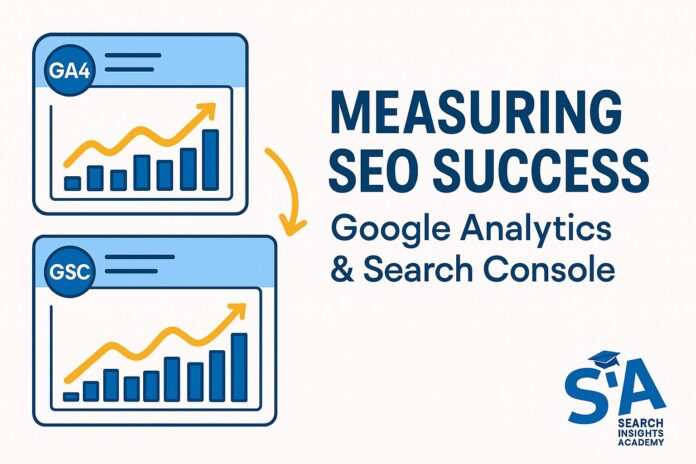Have you ever wondered if your SEO efforts are actually paying off? Do you check your traffic numbers on Facebook or Instagram and ask yourself whether these figures reflect real growth? In today’s fast-paced online environment, it’s vital to track and measure your progress using the right tools. That’s where Google Analytics (GA4) and Google Search Console (GSC) come in. These platforms help you see clear evidence of whether your optimizations are working or if you need to refine your strategy.
In this blog post, we’ll explore what Google Search Console is, why it’s so crucial, and how to set it up alongside GA4. We’ll also discuss how to link Google Analytics to Google Search Console, so you can combine both sets of data for richer insights. By the time you’ve finished reading, you’ll understand not only the numbers themselves but also their meaning in the real world.
Overall, our goal is to help you make sense of impressions, clicks, and conversions, plus detect any issues before they hurt your organic visibility. When you know how to interpret your data, you’ll spot Low Hanging Fruit keywords, identify Quick Wins, and refine your keyword strategy. Let’s begin our journey into measuring SEO success in a practical, friendly way that demystifies these must-have online tools.
Measuring SEO Success
Why Measuring SEO Success Matters
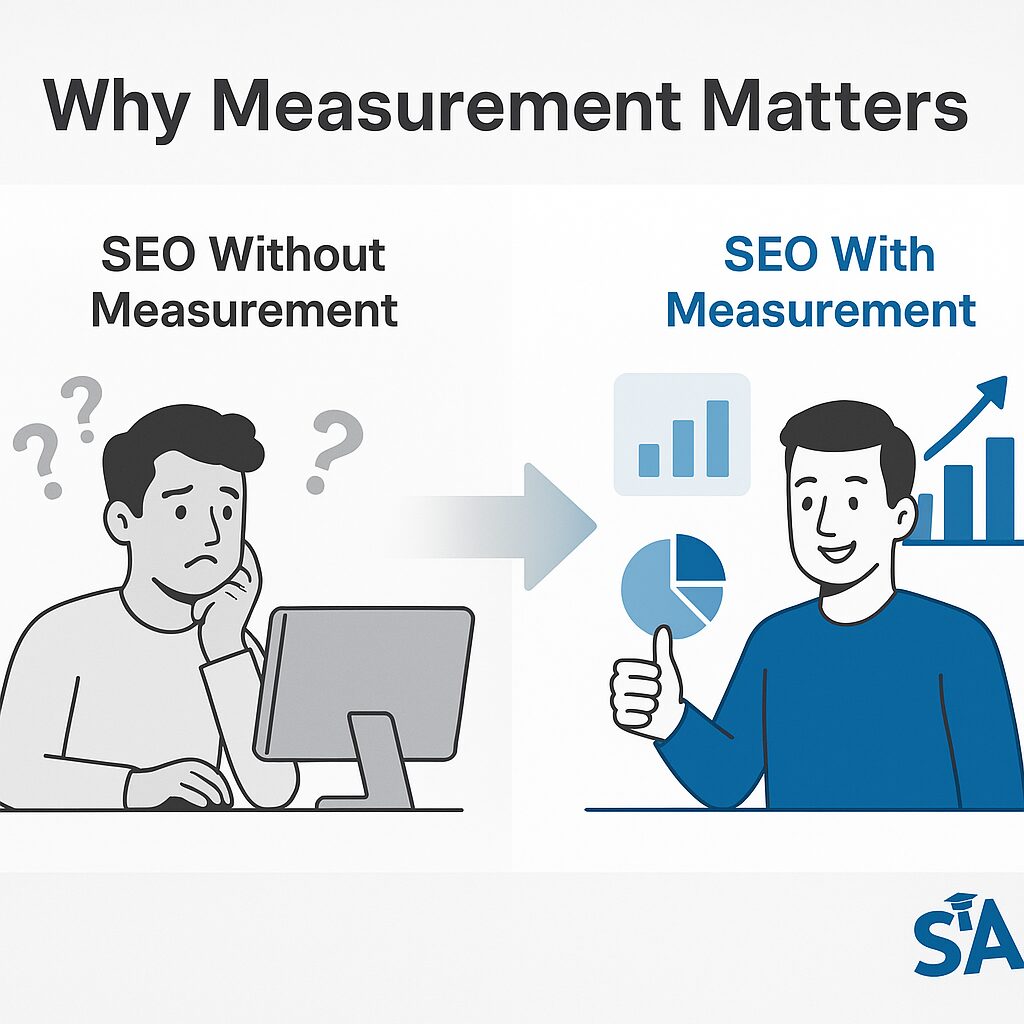
If you’re spending hours crafting top-notch content but not measuring your results, you could be missing valuable guidance on what to improve. Every website, whether it’s a small local blog or a multinational e-commerce brand, needs to keep track of its performance. When you dive into metrics, you gain insights on what resonates with visitors, how they find your site, and whether they follow through on a purchase or enquiry.
By tracking metrics that reveal both user behavior and search performance, you avoid relying on guesswork. Measuring SEO success keeps you focused on achievable keywords rather than chasing overly competitive targets. It also alerts you to sudden changes, like a traffic drop, which might stem from algorithm updates or site issues. In short, data-based decisions lead to continuous improvement.
What You’ll Learn: Setup, Tracking & Interpretation
Throughout this post, we’ll break down everything you need to know. We’ll cover how to create a Google Search Console property, verify it, and submit sitemaps. On top of that, we’ll walk through the basics of setting up a GA4 account—including data streams, conversions, and avoiding common pitfalls.
Once your tools are ready, we’ll explore the core metrics you should watch, such as impressions, clicks, and bounce rate. Then we’ll look at how to interpret SEO performance, from uncovering high-traffic keywords to spotting issues with indexing or engagement. By the end, you’ll have a clear plan for gathering actionable insights and using them to guide your SEO strategy.
Overview of GA4 & Google Search Console

Google Analytics 4 (GA4) is Google’s latest version of its analytics platform. It focuses on event-based tracking rather than simply counting page views. This shift makes it easier to measure user journeys across different devices, so you can see how people interact with your content over time. GA4 thrives on data-driven models that also help you forecast user behavior.
Google Search Console, on the other hand, offers a deep look at how Google indexes your pages. It reveals which queries trigger your site, how often people click on your search listings, and any indexing or mobile usability issues. Understanding what is Google Search Console is crucial for ensuring your content is discoverable and ranks as high as possible. Both tools, when used together, can highlight your best-performing pages, direct you to new content opportunities, and even flag major site problems.
Setting Up Google Search Console
Creating & Verifying Your Property
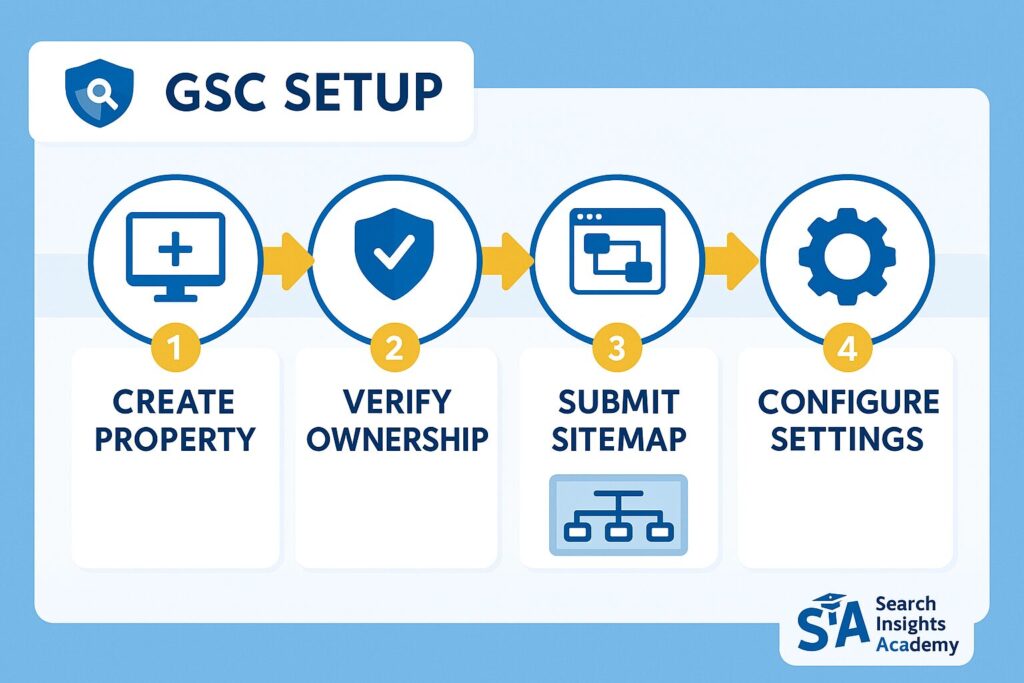
Before you can view data on your site’s search performance, you’ll need to create a property in GSC. To do this, log into your Google account and add your domain or URL prefix. Google may prompt you to verify ownership. Depending on your hosting setup, you might add a TXT record to your DNS or upload an HTML file to your website directory. Don’t stress if this sounds technical—guides within Search Console will walk you through each step.
Verification is critical. It makes sure that only legitimate site owners can access sensitive search data. Once your property is verified, you can start scoping out metrics and learning how people discover your site. If you have multiple domains or subdomains, set up a property for each to see a more complete picture.
Submitting Sitemaps & Setting Preferences
A sitemap is basically a roadmap of all the pages on your website. Submitting one in Google Search Console helps Google crawl and index your site more efficiently. You can create a sitemap using a plugin (such as a popular SEO tool) or by manually generating an XML file.
After submitting your sitemap, you can set additional preferences, like your target country and preferred domain version (e.g., https:// instead of http://). You’ll also get access to the URL inspection tool, which lets you see if specific pages are indexed or flagged with any errors. These preferences don’t guarantee top rankings, but they help signal to Google how you intend your site to be viewed.
GSC Interface Walkthrough
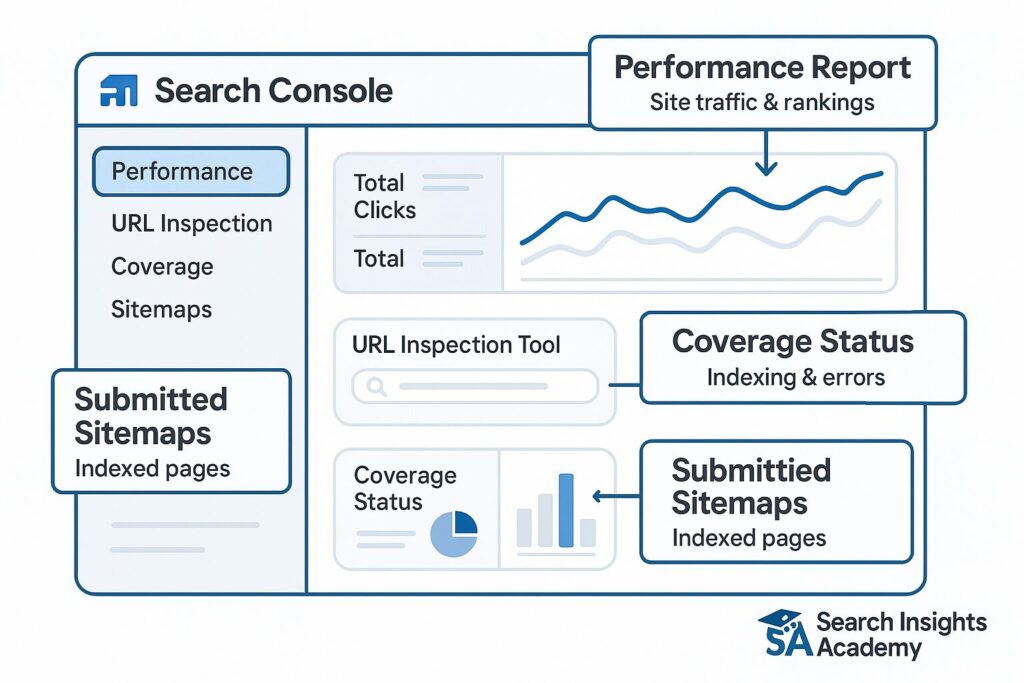
Once you’re inside GSC, you’ll see a dashboard that highlights important stats such as total clicks, impressions, and average position. You can track performance in specific countries, filter out certain queries, and compare date ranges. Reports like Coverage show any indexing issues, while Mobile Usability reports highlight any mobile-friendly problems.
Pay special attention to enhancements such as structured data for products, events, or FAQs. If your site uses these features, GSC will flag any errors or warnings. Over time, you can watch these elements improve and measure how they impact click-through rates (CTR). Becoming confident with the GSC interface empowers you to make data-driven decisions for sustainable SEO growth.
Setting Up Google Analytics (GA4)

Creating an Account & Installing the GA Tag
To begin, head to the Google Analytics home page and create a new account. Once logged in, you’ll add a data stream for your website, which generates a Measurement ID. This code is added to your website so GA4 can track user interactions. Many content management systems (CMS) let you insert your GA tag through a simple plugin or an integrated field in your theme settings.
Copying and pasting the GA tag might sound straightforward, but always verify your tag is active and tracking visits properly. GA4 might take a few hours to show real-time data, so don’t panic if numbers aren’t instantly visible. If you run into problems, consult GA4’s debug mode or check your site’s source code to confirm the script is in place.
Configuring Data Streams & Conversions
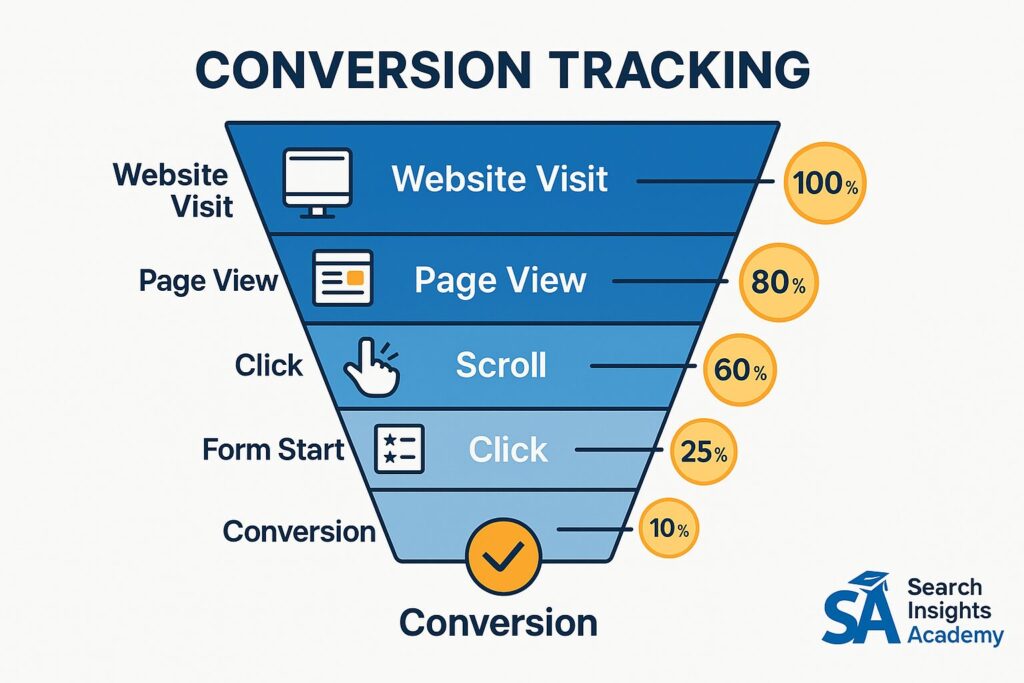
GA4’s data streams group incoming data from websites or apps. If you operate multiple platforms—like a website, mobile app, or even a separate blog—you can set up separate streams. This keeps data organized and helps you understand where your audiences spend most of their time.
Conversions, meanwhile, track valuable actions you want users to take, such as filling out a contact form or making a purchase. In GA4, you can mark certain events as conversions with just a toggle. By focusing on micro-conversions, like newsletter sign-ups, you also gain a better sense of how users engage along the path to your main goals. Tracking conversions keeps you aware of which strategies deliver real results and which ones need attention.
Common Setup Mistakes to Avoid
One common mistake is creating duplicate tags. Having multiple GA scripts can inflate your pageview data, making it look like you’re getting more visitors than you actually are. Another pitfall is failing to exclude internal traffic, such as visits from your staff, which skews your figures.
Sometimes, site owners forget to enable event tracking for essential interactions like button clicks or video plays. This can result in missed insights about how people use your site. Finally, be sure you have permission levels set up correctly. If multiple stakeholders require access, ensure they have the right privileges without exposing sensitive information inadvertently.
Connecting Google Analytics & Search Console
How to Link the Two Tools
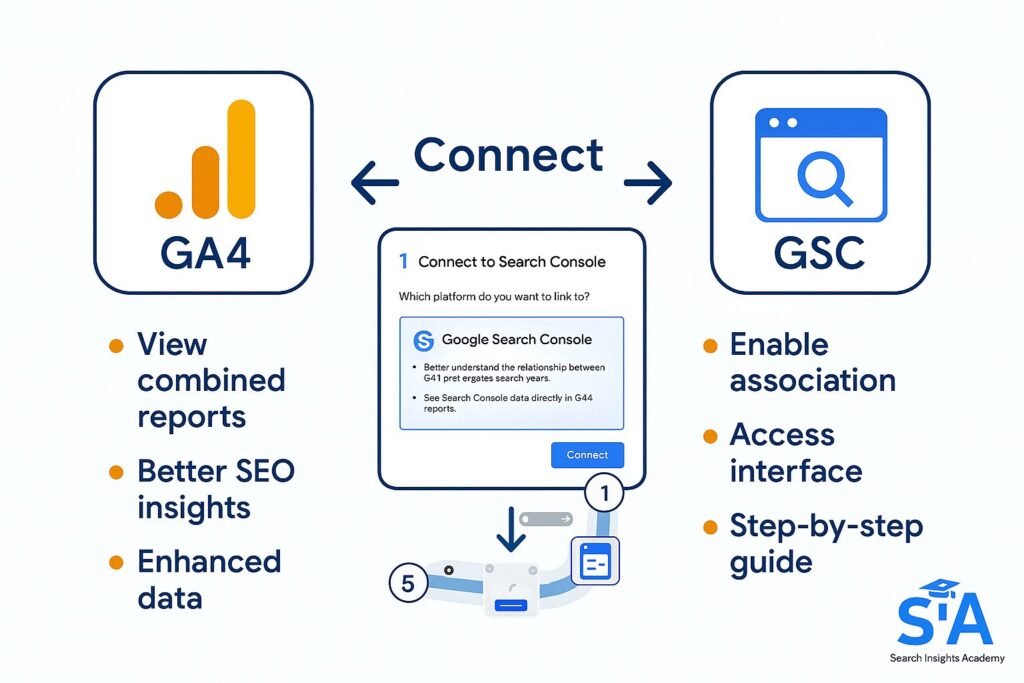
If you’re curious how to link Google Analytics to Google Search Console, you’re not alone. A linked setup allows data to flow seamlessly between GA4 and GSC. In GA4, you’ll find an option under Admin > Property Settings to connect to Search Console. You’ll be guided to select the appropriate GSC property, after which you confirm access. Once linked, you can view Search Console reports in GA4 and unify data on impressions, clicks, and on-site engagement.
Linking the two tools is one of the easiest ways to see the full SEO picture. You can identify which keywords bring in traffic (from GSC) and then see how these visitors behave once they land on your pages (via GA4). This combined data unveils potential gaps, like high click-through but low conversions, or decent on-site engagement but weak search visibility.
Troubleshooting Syncing Issues
Sometimes, the link doesn’t go as planned. You might see messages like “insufficient permissions,” which usually means you need to be listed as a verified owner in GSC. If multiple people manage your site, confirm who holds ownership rights. Another issue arises if the property type in GSC doesn’t match the protocol (http vs. https) or domain set up in GA4.
Patience also helps because it can take up to 48 hours for synced data to appear. If you recently verified your property or just added the GA tag, give the tools time to populate. Finally, double-check that you’re looking in the correct GA4 property. Mixing up test accounts or older UA properties sometimes leads to confusion.
Benefits of Combined Data Reporting
When GA4 and GSC data live together, you unlock a goldmine of insights. For instance, you can see which search queries produce the most clicks and then cross-reference whether visitors stick around or bounce. This insight helps you focus on quick wins, such as optimizing pages that already get decent traffic but might need extra polishing to convert better.
Additionally, combined reporting reveals how changes in search visibility align with on-page user behavior. If your SERP (Search Engine Results Page) impressions are rising but conversions aren’t, you can refine page content or calls to action. This holistic view is a step beyond just checking vanity metrics. It pushes you toward continuous improvement and helps you make better decisions about which keywords to target next.
Tracking Key SEO Metrics
Impressions, Clicks & CTR (GSC)

In GSC, you’ll find a performance report that shows impressions (the total times your page appears in search results), clicks (the number of times someone actually clicks your listing), and click-through rate (CTR). CTR is calculated by dividing clicks by impressions and multiplying by 100. A low CTR might mean your meta title or description needs more punch, while a high CTR indicates your snippet resonates with searchers.
You can filter this data by country, date range, or device type. If local audiences are your main focus, you might compare those figures against international ones to see if you need more localized content. Over time, tracking trends in impressions, clicks, and CTR will highlight whether your keyword positions are stable or if you need to adjust your strategy.
Bounce Rate, Session Duration & Page Views (GA)
Over in GA4, bounce rate captures the percentage of sessions that involved only one pageview before users left. A high bounce rate isn’t always bad—sometimes people find what they need straight away and leave. However, if you want visitors to engage more, a decreasing bounce rate can be a sign of improvement.
Session duration tells you how long users stay on your site overall, while page views measure how many pages get loaded within a session. These metrics can indicate if your internal link structure entices people to browse farther. You might notice certain types of content generate longer sessions—this is your cue to create more of that format.
Conversion Tracking & Micro-Conversions
While clicks and impressions show your popularity, conversions reflect actions aligned with your business goals. A conversion can be anything from an email signup to a webinar registration. In GA4, you mark an event as a conversion so that it’s easy to identify in analyses. Aim to track micro-conversions as well, such as a user adding an item to the cart. These smaller steps lead up to the main goal and offer clues on where users might drop off.
Tracking conversions is essential for turning raw traffic into tangible outcomes. With GSC showing you the keywords that bring visitors in, and GA4 showing whether they take the next step, you can prioritize improvements to the stages that truly matter. This synergy helps you quickly spot which keywords are generating user actions and which ones may need a refresh.
Interpreting SEO Performance Data
Understanding Traffic Trends & Sources
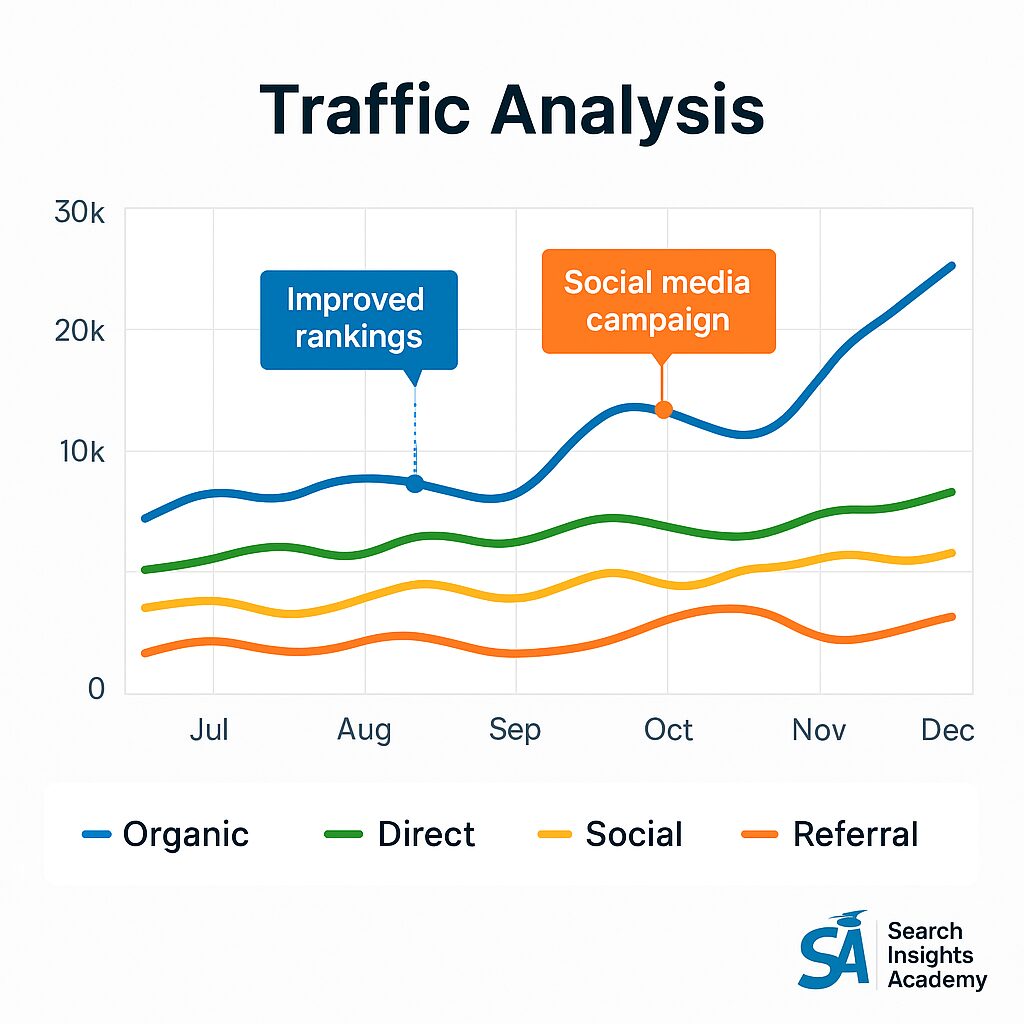
Analyzing traffic trends can feel overwhelming if you’re not sure where to look. Start by checking whether your organic traffic is growing or declining. You can also break it down by source—are people coming from search engines, social media platforms like Twitter, or referral links from other websites? If your organic search traffic is on the rise, your SEO strategy is likely on the right track.
Looking at day-to-day or week-to-week changes can be helpful, but monthly comparisons often yield clearer patterns. For instance, a small local business might see steady traffic dips on weekends when fewer people are online. Strictly focusing on daily fluctuations can create unnecessary panic or excitement. Keep your eye on broader trends, and compare against seasonal variations or large marketing campaigns.
Identifying Top Performing Pages & Queries
To find your star performers, look at which pages get the most visits. Then see how many conversions those pages drive. If certain blog posts attract a high volume of organic visitors, but few conversions, consider adding more in-page calls to action or relevant internal links. Conversely, if you spot pages with fewer clicks but a higher conversion rate, investigate how you can replicate that success.
GSC’s query report shows the search terms users typed in before visiting your pages. You might find that some Low Hanging Fruit keywords—those for which you rank fairly well but not necessarily on page one—are only a few tweaks away from generating more traffic. By refining these pages, you can turn good rankings into great ones.
Spotting Issues: Indexing, Engagement & Drop-offs
If your impressions drop suddenly, it may signal indexing issues. Check GSC’s Coverage section to see if pages are getting deindexed or flagged with errors. Another sign of trouble is an unexpected spike in bounce rate or a sharp dip in average session duration. This could indicate that a page is loading slowly, or content is failing to meet user expectations.
Watch for patterns in drop-offs, especially in multi-step processes like form submissions or checkout flows. A consistent exit point might signal a mismatch between user expectations and the page’s layout or messaging. Early detection of these issues can spare you from a more significant drop in organic rankings and keep your SEO performance healthy.
Keyword Strategy with GA & GSC
Finding Low Hanging Fruit & Quick Wins
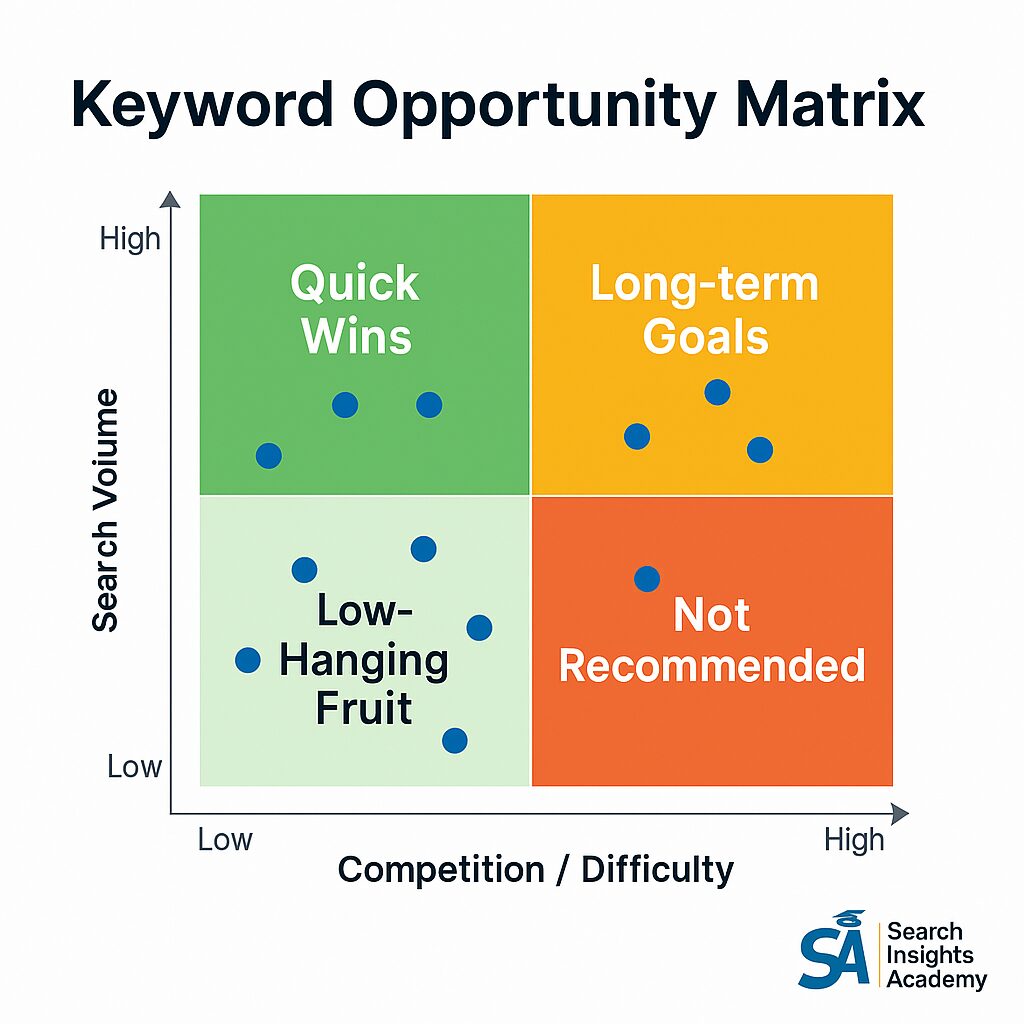
One straightforward tactic is to look for keywords where your page ranks in the top 20 results but not quite on page one. These are often Low Hanging Fruit keywords and can deliver quick wins if you update the content or optimize meta tags. GSC helps you see average positions and click-through rates; combine that with GA4 metrics like time on page or conversions.
Whenever you spot a keyword that has a decent CTR but fails to convert, consider tweaking your page layout or call to action. On the flip side, if a keyword has a poor CTR but ranks well, your snippet might need a better hook. By paying attention to both sets of metrics, you identify small changes that can yield big improvements.
Analysing Keyword Intent & Performance
Not all clicks are created equal. Some keywords have commercial intent, meaning they signal a user’s readiness to buy or otherwise engage. Others are purely informational. GSC queries can help you distinguish intent by looking at how users interact after clicking. If you see a high bounce rate, you might be targeting the wrong search intent.
Meanwhile, GA4 can show how well visitors from these keywords flow through your site. Do they visit multiple pages, or do they exit immediately? Keywords matching user intent often have better engagement metrics. Keep refining your content to match the questions or needs that brought the audience to your page in the first place.
Prioritising Keywords by Traffic & Difficulty
Focusing on high-volume keywords might seem tempting, but “high volume” can also mean high competition. It’s often more effective to target a mix of moderately competitive keywords, especially if they fit your brand’s purpose. Tools outside of GA and GSC can estimate keyword difficulty, but the data from GSC about your current positions will give you a more accurate gauge of feasibility.
When deciding which keywords to tackle first, weigh potential traffic gains against the effort required. If you have a page that’s already partially optimized, it may take less time to boost its ranking compared to creating new content from scratch. A balanced approach, targeting both realistic gains and ambitious goals, can pave the way for consistent growth in organic traffic.
Best Practices for Ongoing Monitoring
How Often to Review Your Data
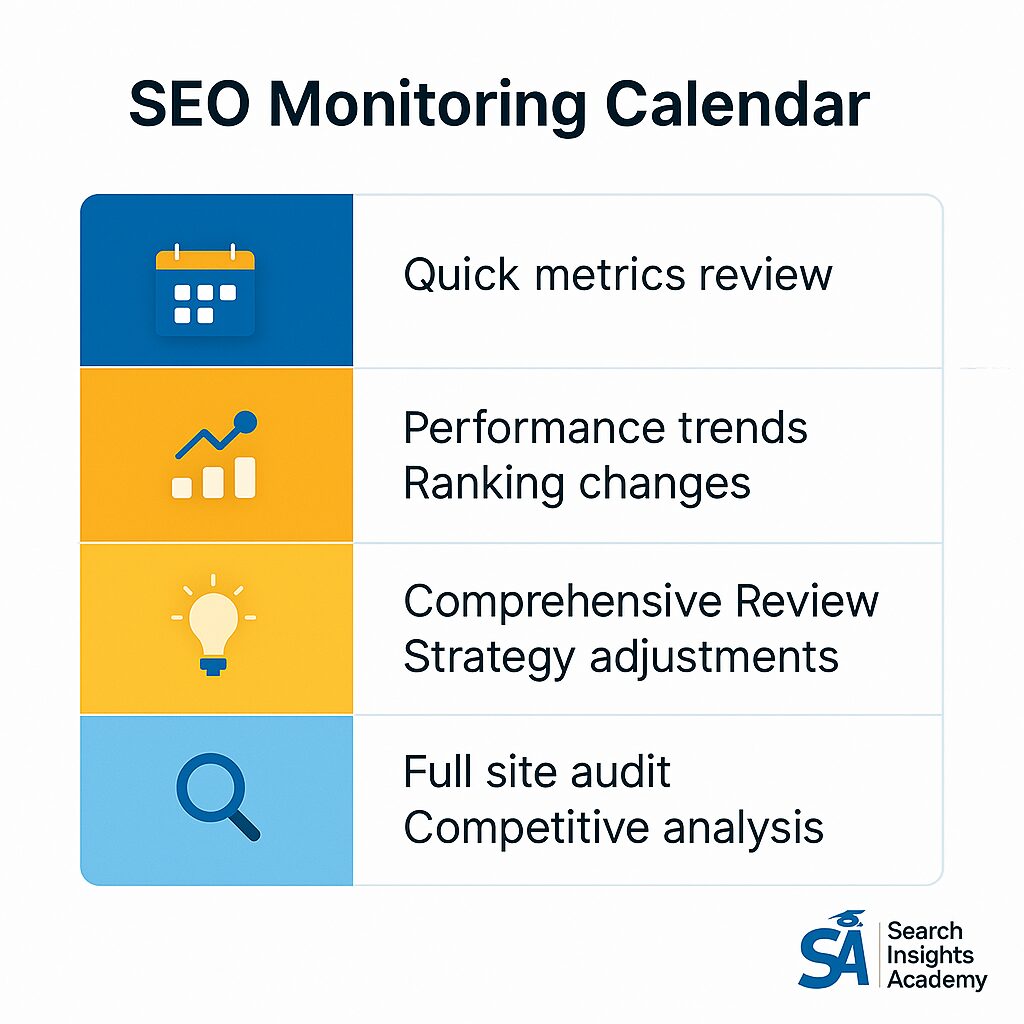
There’s no one-size-fits-all answer to data review frequency. However, a weekly check-in usually helps catch any sudden changes or errors. You might review the basics—clicks, impressions, bounce rate—at least once a week. A more thorough analysis, including traffic segmentation and conversion trends, could be done monthly.
If your site experiences frequent content updates or seasonal changes, you might need more frequent tracking. The important thing is setting a schedule you can keep consistently. Regular monitoring prevents problems from spiraling out of control and ensures you stay aligned with your KPIs.
Setting SEO KPIs & Tracking Progress
Key performance indicators (KPIs) should reflect your specific goals, not just vanity metrics. For some businesses, the ultimate KPI may be online sales, while for others it could be contact form submissions or eBook downloads. Link these KPIs to actual metrics in GSC (clicks, position) and GA4 (sessions, conversions) for a clear snapshot of progress.
Over time, track whether you’re meeting your KPIs. If you’re falling short, try experimenting with new keywords, updating old content, or exploring alternative promotional channels. Keeping a close eye on how each tweak affects your KPIs enables you to pick strategies that produce real results, instead of wasting time on guesswork.
Using Reports to Inform Content Strategy
GSC offers data on which queries are rising in popularity, and GA4 shows the engagement on your existing pages. Combined, they can guide your future blog posts or product pages. For example, if you see an emerging keyword trend in GSC, create content aimed at capturing that audience. Meanwhile, let the bounce rate and session duration in GA4 tell you whether your new content resonates.
Consider also your audience demographics, which GA4 can provide if you’ve enabled that feature. If your user base skews younger or older than expected, tailor language and content topics to speak directly to them. This data-driven approach moves your content strategy beyond mere intuition into a proven system for attracting and engaging your target market.
Common Questions & Troubleshooting
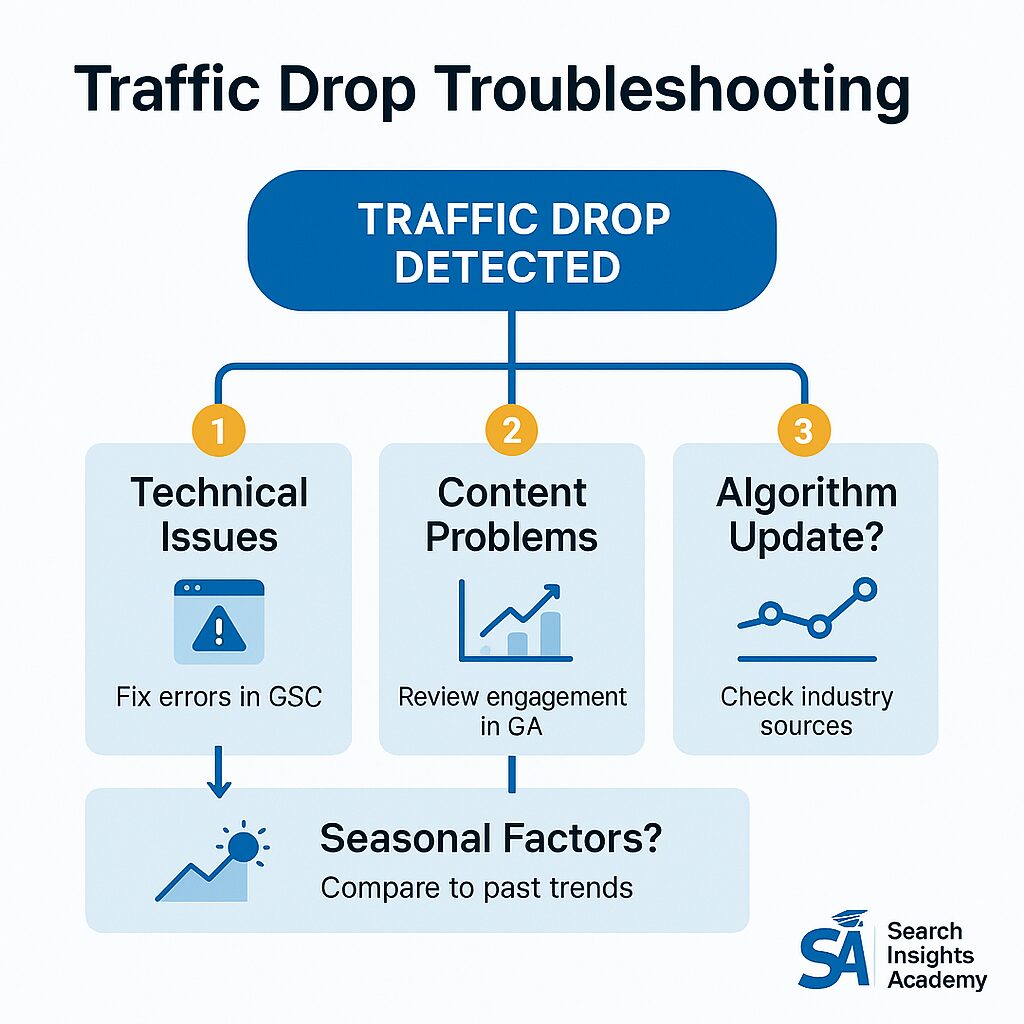
Why Use Both GA & GSC?
People often wonder if GA4 alone is enough. The truth is, GA shows what happens on your site, while GSC shows how searchers reach your site in the first place. By using both, you gain a complete picture of the journey—everything from initial impression to final conversion. This synergy clarifies how your SEO efforts tie into user behavior and helps you spot gaps quickly.
What If My Traffic Drops?
A sudden traffic drop can feel alarming, but don’t panic. Check GSC first to see if your impressions are also dropping or if it’s primarily clicks that are down. Look for any crawl errors or warnings about mobile usability. Then inspect GA4 to see if certain pages or geographical regions are more affected. Changes in Google’s algorithm, technical issues with your site, or shifts in consumer behavior (like a seasonality dip) could be the culprit. Identifying the root cause helps you act swiftly, whether that’s fixing broken links, updating content, or refining your keyword strategy.
Can These Tools Help with Technical SEO?
Yes, both tools can help you stay on top of technical SEO tasks. GSC flags crawling or indexing issues, while GA4 can reveal if certain pages face high bounce rates potentially linked to slow loading times. These insights help you pinpoint where to make technical fixes—like improving page speed or resolving structured data errors—so your site is more appealing to both users and search engines.
Conclusion

Google Analytics 4 and Google Search Console are a powerful combination for anyone serious about SEO success. Together, they make sure you see not just traffic numbers but also how visitors engage, convert, or even exit your site. When you link the two platforms, you’ll gain a richer view of your performance across the full spectrum—from the search results page right through to on-site user actions.
In practical terms, this means you can identify Low Hanging Fruit keywords, track impressions and clicks, and then see exactly how people behave once they land on your content. You’ll spot pages that attract loads of visitors but drive few conversions, as well as those that convert well but need more search visibility. Each insight nudges you to refine your strategy so that you waste less time guessing and more time amplifying what works.
Finally, remember that this is an ongoing process. SEO isn’t about a one-time fix; it’s about continuous adaptation—keeping an eye on trends, refining your content, and staying alert to changes in your data. Armed with the tips we’ve explored, you’ll be able to chart a long-running path to growth, ensuring that every campaign, blog post, and tweak to your website aligns with your broader goals. Make the most of GA4 and GSC, and watch your online presence soar.
Key Takeaways & Pro Tips
- Track core GSC metrics (impressions, clicks, CTR) alongside GA4’s session and conversion data to gain an all-in-one perspective.
- Prioritize keywords carefully, focusing on quick wins for short-term boosts and tackling more competitive terms for sustained growth.
- Keep your eyes peeled for technical issues flagged by both tools—sorting them out quickly safeguards your search visibility.
Next Steps: Maintain & Improve SEO Performance
- Check in on your analytics and console data weekly or monthly, depending on your site’s size and activity.
- Fine-tune your keyword strategy as new opportunities emerge and user behavior changes.
- Refine your title tags, meta descriptions, and on-page content to keep bounce rates and exit rates low, while boosting conversions.
- Stay curious, continue experimenting, and always let real data guide your decisions. By doing so, you’ll transform your SEO efforts into a sustained success story, ready to grow and evolve in harmony with your goals.

